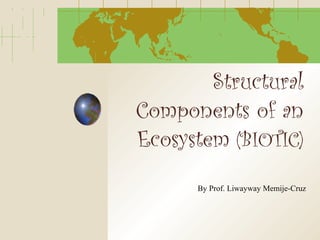Structural Components of an Ecosystem (Biotic)
•Transferir como PPT, PDF•
79 gostaram•3,323 visualizações
The biotic elements that comprise an ecosystem fall into one of several trophic levels. The trophic level of an organism is its position in a food chain, the sequence of consumption and energy transfer through the environment.
Denunciar
Compartilhar
Denunciar
Compartilhar

Recomendados
Mais conteúdo relacionado
Mais procurados
Mais procurados (20)
Lesson 4 Ecosystem functions and ecosystem services

Lesson 4 Ecosystem functions and ecosystem services
Semelhante a Structural Components of an Ecosystem (Biotic)
Semelhante a Structural Components of an Ecosystem (Biotic) (20)
20MNT31 & Environmental Science - Ecosystem (2023-24-II-AIDS-B).ppt

20MNT31 & Environmental Science - Ecosystem (2023-24-II-AIDS-B).ppt
Mais de Liwayway Memije-Cruz
Mais de Liwayway Memije-Cruz (20)
Second-level Digital Divide and experiences of Schools and Teachers

Second-level Digital Divide and experiences of Schools and Teachers
Human flourishing in science and technology: Technology as a Mode of Revealing

Human flourishing in science and technology: Technology as a Mode of Revealing
Último
Último (20)
Human & Veterinary Respiratory Physilogy_DR.E.Muralinath_Associate Professor....

Human & Veterinary Respiratory Physilogy_DR.E.Muralinath_Associate Professor....
TransientOffsetin14CAftertheCarringtonEventRecordedbyPolarTreeRings

TransientOffsetin14CAftertheCarringtonEventRecordedbyPolarTreeRings
development of diagnostic enzyme assay to detect leuser virus

development of diagnostic enzyme assay to detect leuser virus
POGONATUM : morphology, anatomy, reproduction etc.

POGONATUM : morphology, anatomy, reproduction etc.
PATNA CALL GIRLS 8617370543 LOW PRICE ESCORT SERVICE

PATNA CALL GIRLS 8617370543 LOW PRICE ESCORT SERVICE
Site specific recombination and transposition.........pdf

Site specific recombination and transposition.........pdf
Cyathodium bryophyte: morphology, anatomy, reproduction etc.

Cyathodium bryophyte: morphology, anatomy, reproduction etc.
FAIRSpectra - Enabling the FAIRification of Analytical Science

FAIRSpectra - Enabling the FAIRification of Analytical Science
Genetics and epigenetics of ADHD and comorbid conditions

Genetics and epigenetics of ADHD and comorbid conditions
Role of AI in seed science Predictive modelling and Beyond.pptx

Role of AI in seed science Predictive modelling and Beyond.pptx
Cot curve, melting temperature, unique and repetitive DNA

Cot curve, melting temperature, unique and repetitive DNA
LUNULARIA -features, morphology, anatomy ,reproduction etc.

LUNULARIA -features, morphology, anatomy ,reproduction etc.
GBSN - Microbiology (Unit 3)Defense Mechanism of the body 

GBSN - Microbiology (Unit 3)Defense Mechanism of the body
Structural Components of an Ecosystem (Biotic)
- 1. Structural Components of an Ecosystem (BIOTIC) By Prof. Liwayway Memije-Cruz
- 2. Web of Life
- 3. The scientific study of the distribution and abundance of living organisms and how the distribution and abundance are affected by interactions between the organisms and their environment. Ecology
- 4. Definitions of Ecology: the study of organisms at home the study of the relationships of organisms or groups of organisms to their environment the science of interrelationships between living organisms to their environment totality of man to their environment
- 6. Photosynthesis The trapping of solar energy and its conversion to chemical energy, which is used in manufacturing of food molecules. from carbon dioxide and water.
- 9. Respiration – the metabolic assimilation of oxygen with production of carbon dioxide and water, release of energy and breaking down of organic substances
- 10. Ecosystem includes all of the living things: plants, animals and organisms in a given area, interacting with each other, and also with their non-living environments like weather, earth, sun, soil, climate and atmosphere.
- 11. Trophic Level The steps involved in the flow of energy through an ecosystem. the position that an organism occupies in a food chain - what it eats, and what eats it.
- 12. Producers or autotrophs the organisms which utilize energy from the sun and nutrients from the abiotic environment to perform photosynthesis and grow. generally the green plants able to produce or build its own complex organic molecule from simple inorganic substance in the environment.
- 13. Photosynthetic autotrophs are organisms able to build all of the organic molecules it requires using carbon dioxide as the carbon source and sunlight as the energy source. Examples: bacteria and plants
- 14. Chemosynthetic autotrophs few kinds of bacteria able to build all the organic molecules it requires carbon dioxide as the carbon source and certain inorganic substances (sulfur) as the energy source. Examples: sulfur bacteria
- 15. Consumers or heterotrophs Organisms that feed on other organisms Herbivores - animals that get its energy from eating plants, and only plants. Carnivores - animals that get food from killing and eating other animals. Omnivores - animals that eat either other animals or plants. Some are scavengers and eat dead matter. Decomposers and Detritivores are animals that utilize energy from wastes or dead organisms.
- 16. Food Chain The passage of energy from one tropic level to the next as a result of one organism consuming another
- 17. Food web A network of interlinked food chains composed of primary producers and decomposers
